前面介绍了GUI及其创建步骤,从现在开始在对一些简单的实例进行实际操作,进一步熟悉GUI的创建步骤,本次先介绍两个实例。
实例一: 将一张彩色图像转化为黑白图像(彩色图像灰度化)。
第一步:GUIDE画界面。创建一个空的GUI界面,将需要的控件从左侧拖至右侧界面,并改变其属性。
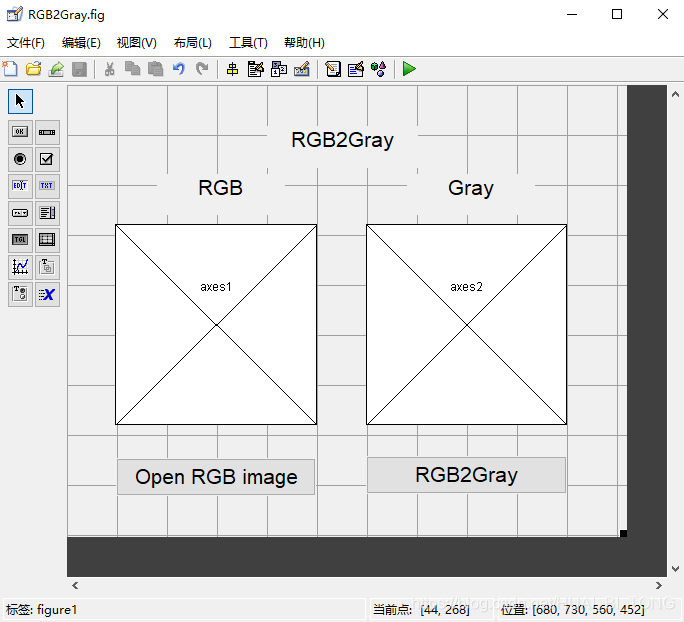
第二步:编辑代码。在完成第一步后,点击“运行图窗”按钮,进入代码编辑界面。
function varargout=RGB2Gray(varargin)
% RGB2GRAY MATLAB code for RGB2Gray.fig
% RGB2GRAY, by itself, creates a new RGB2GRAY or raises the existing
% singleton*.
%
% H = RGB2GRAY returns the handle to a new RGB2GRAY or the handle to
% the existing singleton*.
%
% RGB2GRAY('CALLBACK',hObject,eventData,handles,...) calls the local
% function named CALLBACK in RGB2GRAY.M with the given input arguments.
%
% RGB2GRAY('Property','Value',...) creates a new RGB2GRAY or raises the
% existing singleton*. Starting from the left, property value pairs are
% applied to the GUI before RGB2Gray_OpeningFcn gets called. An
% unrecognized property name or invalid value makes property application
% stop. All inputs are passed to RGB2Gray_OpeningFcn via varargin.
%
% *See GUI Options on GUIDE's Tools menu. Choose "GUI allows only one
% instance to run (singleton)".
%
% See also: GUIDE, GUIDATA, GUIHANDLES
% Edit the above text to modify the response to help RGB2Gray
% Last Modified by GUIDE v2.5 26-Jul-2019 14:11:52
% Begin initialization code - DO NOT EDIT
gui_Singleton = 1;
gui_State = struct('gui_Name', mfilename, ...
'gui_Singleton', gui_Singleton, ...
'gui_OpeningFcn', @RGB2Gray_OpeningFcn, ...
'gui_OutputFcn', @RGB2Gray_OutputFcn, ...
'gui_LayoutFcn', [] , ...
'gui_Callback', []);
if nargin && ischar(varargin{1})
gui_State.gui_Callback = str2func(varargin{1});
end
if nargout
[varargout{1:nargout}] = gui_mainfcn(gui_State, varargin{:});
else
gui_mainfcn(gui_State, varargin{:});
end
% End initialization code - DO NOT EDIT
% --- Executes just before RGB2Gray is made visible.
function RGB2Gray_OpeningFcn(hObject, eventdata, handles, varargin)
% This function has no output args, see OutputFcn.
% hObject handle to figure
% eventdata reserved - to be defined in a future version of MATLAB
% handles structure with handles and user data (see GUIDATA)
% varargin command line arguments to RGB2Gray (see VARARGIN)
% Choose default command line output for RGB2Gray
handles.output = hObject;
handles.imgfilename=[];
handles.imgdata=[];
handles.imgoutput=[];
% Update handles structure
guidata(hObject, handles);
% UIWAIT makes RGB2Gray wait for user response (see UIRESUME)
% uiwait(handles.figure1);
% --- Outputs from this function are returned to the command line.
function varargout = RGB2Gray_OutputFcn(hObject, eventdata, handles)
% varargout cell array for returning output args (see VARARGOUT);
% hObject handle to figure
% eventdata reserved - to be defined in a future version of MATLAB
% handles structure with handles and user data (see GUIDATA)
% Get default command line output from handles structure
varargout{1} = handles.output;
% --- Executes on button press in open.
function open_Callback(hObject, eventdata, handles)
% hObject handle to open (see GCBO)
% eventdata reserved - to be defined in a future version of MATLAB
% handles structure with handles and user data (see GUIDATA)
[imgfilename imgpathname]=uigetfile({'*.bmp;*.jpg;*.png;*.jpeg;*.tif;*.gif;*.Image files'},'载入图像');%打开图像
if imgfilename
imgdata=imread([imgpathname '\' imgfilename]);
image(handles.axes1,imgdata); %在axes1中显示图像
handles.imgfilename=imgfilename;
handles.imgdata=imgdata;
end
guidata(hObject,handles)
% --- Executes on button press in RGB2Gray.
function RGB2Gray_Callback(hObject, eventdata, handles)
% hObject handle to RGB2Gray (see GCBO)
% eventdata reserved - to be defined in a future version of MATLAB
% handles structure with handles and user data (see GUIDATA)
if~isempty(handles.imgfilename)
imgoutput=rgb2gray(handles.imgdata);
image(handles.axes2,imgoutput)
colormap(handles.axes2,gray(256))
handles.imgoutput=imgoutput;
end
guidata(hObject,handles)
第三步:运行。在完成第一步和第二步后,点击MATLAB编辑器下面的“运行”按钮,会显示设计好的GUI界面。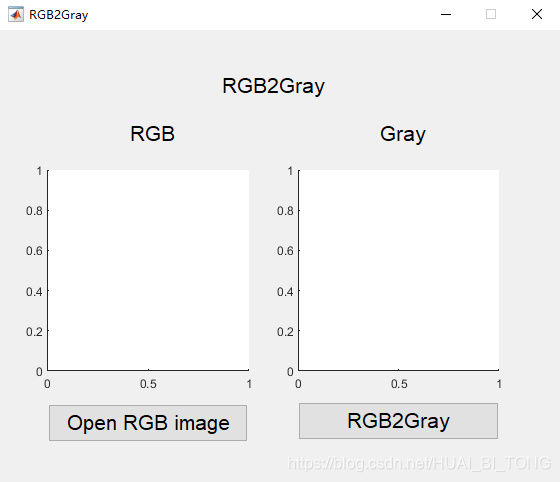
第四步:在完成GUI界面创建后,对所创建界面的效果进行试验。先点击“Open RGB image"按钮选择一张彩色图像,再点击“RGB2Gray”按钮,就可以得到灰度图像。

实例二: 做一个录音机界面。
第一步:GUIDE画界面。
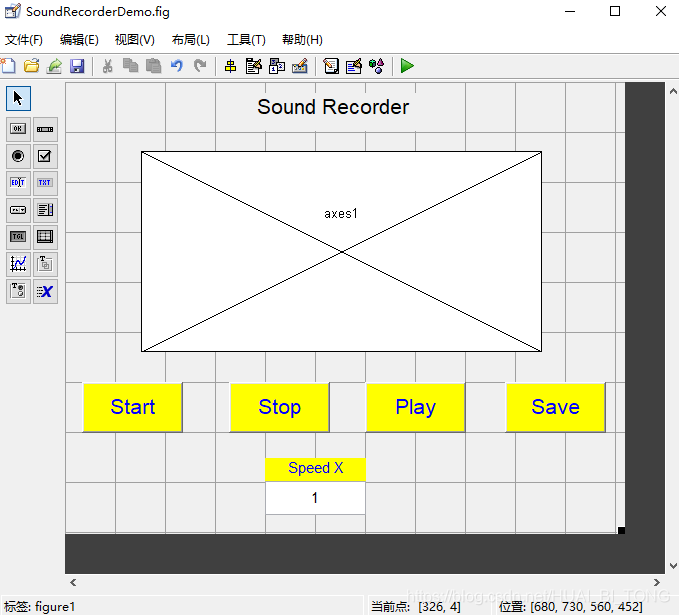
第二步:编辑代码。
function varargout = SoundRecorderDemo(varargin)
% SOUNDRECORDERDEMO MATLAB code for SoundRecorderDemo.fig
% SOUNDRECORDERDEMO, by itself, creates a new SOUNDRECORDERDEMO or raises the existing
% singleton*.
%
% H = SOUNDRECORDERDEMO returns the handle to a new SOUNDRECORDERDEMO or the handle to
% the existing singleton*.
%
% SOUNDRECORDERDEMO('CALLBACK',hObject,eventData,handles,...) calls the local
% function named CALLBACK in SOUNDRECORDERDEMO.M with the given input arguments.
%
% SOUNDRECORDERDEMO('Property','Value',...) creates a new SOUNDRECORDERDEMO or raises the
% existing singleton*. Starting from the left, property value pairs are
% applied to the GUI before SoundRecorderDemo_OpeningFcn gets called. An
% unrecognized property name or invalid value makes property application
% stop. All inputs are passed to SoundRecorderDemo_OpeningFcn via varargin.
%
% *See GUI Options on GUIDE's Tools menu. Choose "GUI allows only one
% instance to run (singleton)".
%
% See also: GUIDE, GUIDATA, GUIHANDLES
% Edit the above text to modify the response to help SoundRecorderDemo
% Last Modified by GUIDE v2.5 26-Jul-2019 15:02:18
% Begin initialization code - DO NOT EDIT
gui_Singleton = 1;
gui_State = struct('gui_Name', mfilename, ...
'gui_Singleton', gui_Singleton, ...
'gui_OpeningFcn', @SoundRecorderDemo_OpeningFcn, ...
'gui_OutputFcn', @SoundRecorderDemo_OutputFcn, ...
'gui_LayoutFcn', [] , ...
'gui_Callback', []);
if nargin && ischar(varargin{1})
gui_State.gui_Callback = str2func(varargin{1});
end
if nargout
[varargout{1:nargout}] = gui_mainfcn(gui_State, varargin{:});
else
gui_mainfcn(gui_State, varargin{:});
end
% End initialization code - DO NOT EDIT
% --- Executes just before SoundRecorderDemo is made visible.
function SoundRecorderDemo_OpeningFcn(hObject, eventdata, handles, varargin)
% This function has no output args, see OutputFcn.
% hObject handle to figure
% eventdata reserved - to be defined in a future version of MATLAB
% handles structure with handles and user data (see GUIDATA)
% varargin command line arguments to SoundRecorderDemo (see VARARGIN)
% Choose default command line output for SoundRecorderDemo
handles.output = hObject;
handles.recObj = audiorecorder(48000,16,2,-1);
handles.recObj.TimerFcn={@RecDisplay,handles};
handles.recObj.TimerPeriod=0.25;
handles.playSpeed=1;
% Update handles structure
guidata(hObject, handles);
% UIWAIT makes SoundRecorderDemo wait for user response (see UIRESUME)
% uiwait(handles.figure1);
% --- Outputs from this function are returned to the command line.
function varargout = SoundRecorderDemo_OutputFcn(hObject, eventdata, handles)
% varargout cell array for returning output args (see VARARGOUT);
% hObject handle to figure
% eventdata reserved - to be defined in a future version of MATLAB
% handles structure with handles and user data (see GUIDATA)
% Get default command line output from handles structure
varargout{1} = handles.output;
% --- Executes on button press in statt.
function statt_Callback(hObject, eventdata, handles)
% hObject handle to statt (see GCBO)
% eventdata reserved - to be defined in a future version of MATLAB
% handles structure with handles and user data (see GUIDATA)
record(handles.recObj);
% --- Executes on button press in stop.
function stop_Callback(hObject, eventdata, handles)
% hObject handle to stop (see GCBO)
% eventdata reserved - to be defined in a future version of MATLAB
% handles structure with handles and user data (see GUIDATA)
stop(handles.recObj)
% --- Executes on button press in play.
function play_Callback(hObject, eventdata, handles)
% hObject handle to play (see GCBO)
% eventdata reserved - to be defined in a future version of MATLAB
% handles structure with handles and user data (see GUIDATA)
handles.myRecording=getaudiodata(handles.recObj);
handles.playObj=audioplayer(handles.myRecording,handles.playSpeed*handles.recObj.SampleRate);
play(handles.playObj);
guidata(hObject,handles);
% --- Executes on button press in save.
function save_Callback(hObject, eventdata, handles)
% hObject handle to save (see GCBO)
% eventdata reserved - to be defined in a future version of MATLAB
% handles structure with handles and user data (see GUIDATA)
[file,path]=uiputfile(['soundDemo_Speed' num2str(handles.playSpeed) '.wav'],'Save recorded sound');
if file
audiowrite([path '\' file],handles.myRecording,handles.playSpeed*handles.recObj.SampleRate)
end
function RecDisplay(hObject, eventdata, handles)
% handles
handles.myRecording=getaudiodata(handles.recObj)
% axes(handles.axes1)
plot(handles.axes1,(1:length(handles.myRecording))/handles.recObj.SampleRate,handles.myRecording)
drawnow;
function edit1_Callback(hObject, eventdata, handles)
% hObject handle to edit1 (see GCBO)
% eventdata reserved - to be defined in a future version of MATLAB
% handles structure with handles and user data (see GUIDATA)
% Hints: get(hObject,'String') returns contents of edit1 as text
% str2double(get(hObject,'String')) returns contents of edit1 as a double
handles.playSpeed=str2double(get(hObject,'String'));
guidata(hObject,handles)
% --- Executes during object creation, after setting all properties.
function edit1_CreateFcn(hObject, eventdata, handles)
% hObject handle to edit1 (see GCBO)
% eventdata reserved - to be defined in a future version of MATLAB
% handles empty - handles not created until after all CreateFcns called
% Hint: edit controls usually have a white background on Windows.
% See ISPC and COMPUTER.
if ispc && isequal(get(hObject,'BackgroundColor'), get(0,'defaultUicontrolBackgroundColor'))
set(hObject,'BackgroundColor','white');
end
第三步:运行。
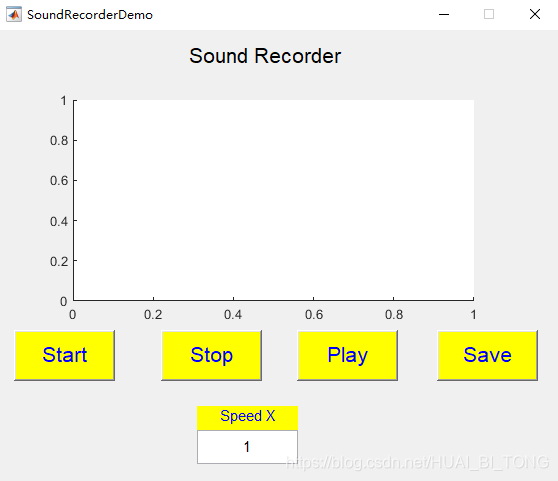
第四步:在完成GUI界面创建后,对所创建界面的效果进行试验。点击“Start”按钮开始录音,点击“Stop”按钮暂停录音,点击“Play”按钮开始播放刚录好的音频,点击“Save”按钮可以将刚录好的音频保存到指定路径。在播放音频时,可以修改可编辑文本框中的播放速度,比如改为“1.5”或“0.75”。
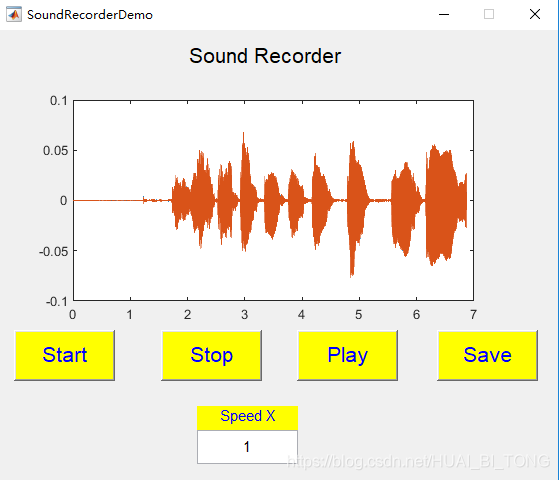






















 3144
3144

 被折叠的 条评论
为什么被折叠?
被折叠的 条评论
为什么被折叠?








